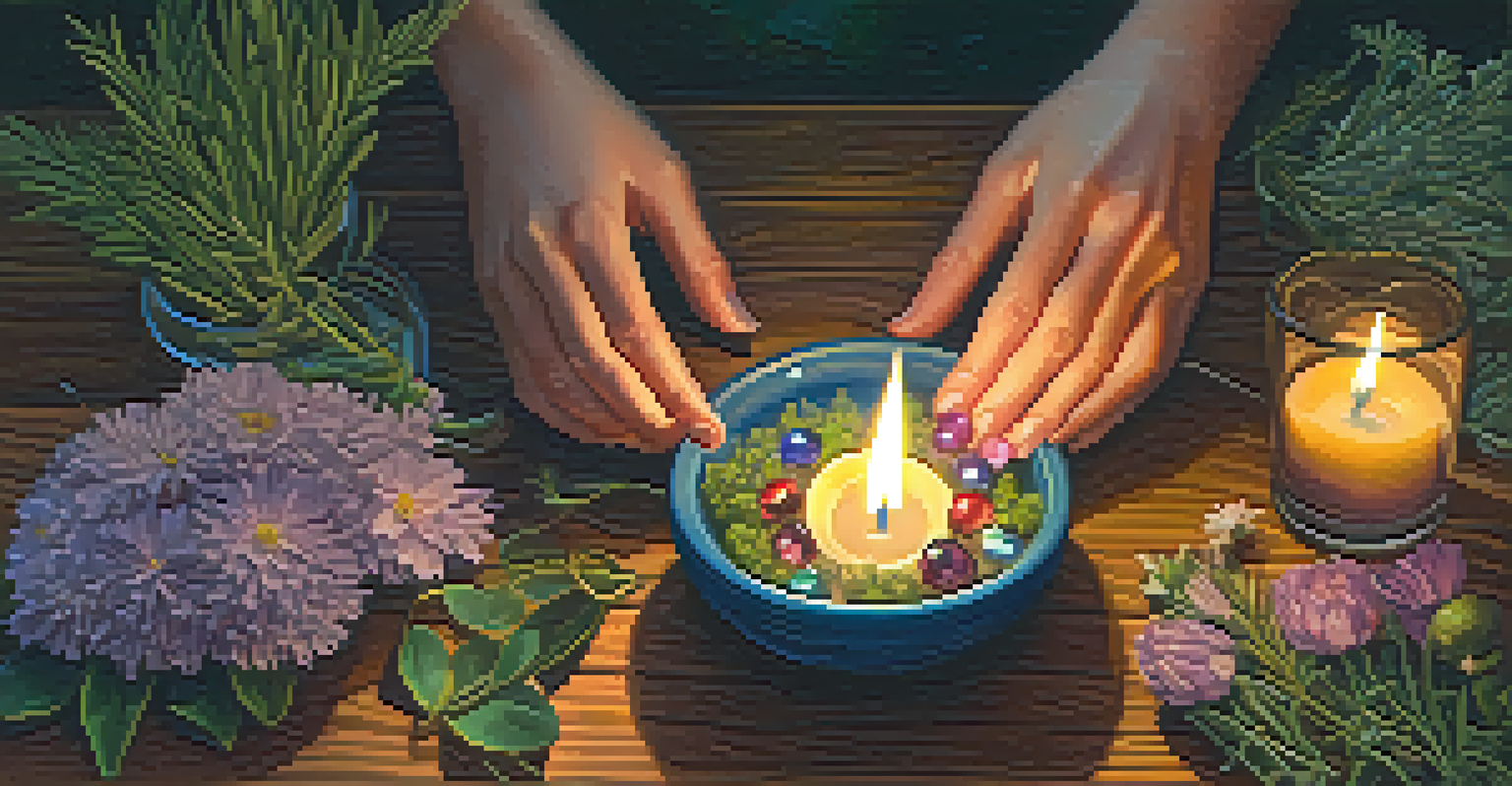Entheogenic Rituals: Historical Practices and Empathetic Growth

Understanding Entheogens: A Brief Overview
Entheogens are substances that can induce altered states of consciousness, often used in spiritual contexts. These natural compounds, such as psilocybin mushrooms, peyote, and ayahuasca, have been employed for centuries by various cultures. They are thought to facilitate deep introspection and connection with the self and the universe.
The experience of entheogens is a journey within, revealing the interconnectedness of all beings.
Throughout history, different civilizations have revered these plants and fungi for their ability to enhance spiritual experiences. For example, Indigenous peoples of the Americas have long used peyote in sacred ceremonies to foster communal bonds and personal healing. Thus, entheogens serve as both a tool for personal growth and a bridge to collective understanding.
Today, there is a renewed interest in these ancient practices, as many are exploring them to foster empathy and emotional growth. This resurgence invites us to reflect on our own experiences and consider how these rituals can enhance our interpersonal connections.
The Historical Roots of Entheogenic Practices
Entheogenic rituals can be traced back thousands of years, with evidence found in ancient texts and archaeological sites. Cultures such as the Aztecs and the Incas incorporated these substances into their religious practices, believing they provided access to the divine. This historical significance highlights how deeply rooted these practices are in human spirituality.

For instance, the use of ayahuasca in the Amazon rainforest serves not only as a spiritual journey but also as a rite of passage for many tribes. Participants often report profound experiences that reshape their understanding of existence and their place within it. This connection to ancestry enriches the cultural tapestry surrounding entheogens.
Entheogens Foster Personal Growth
Experiences with entheogens can lead to significant personal transformations, encouraging individuals to live authentically and with intention.
As we explore these historical practices, we uncover the myriad ways they have shaped human consciousness. Understanding this lineage can inspire modern practitioners to approach entheogens with respect and intention, recognizing their power to transform lives.
Rituals and Their Role in Empathetic Development
Rituals surrounding entheogenic use often create a sacred space that promotes emotional safety and openness. Participants engage in guided ceremonies where they can explore their inner landscapes while being supported by community members. This shared experience fosters empathy, as individuals connect not just with themselves but with each other.
Empathy is the gateway to understanding, and entheogens can be a powerful catalyst for this profound connection.
For example, many ayahuasca ceremonies include singing, drumming, and storytelling, which help to weave a sense of unity among participants. These elements enhance the experience, allowing individuals to express themselves freely and authentically. As a result, many find that they can empathize more deeply with others’ struggles and joys.
Thus, entheogenic rituals are more than just personal journeys; they are communal experiences that can enhance emotional intelligence. By engaging in these practices, individuals often emerge with a heightened sense of compassion and understanding for those around them.
Personal Growth Through Entheogenic Experiences
Many people report significant personal transformations following entheogenic experiences. These journeys often encourage introspection and a reevaluation of life choices, leading to newfound clarity and purpose. Such insights can be pivotal in encouraging individuals to live authentically and with intention.
For instance, someone may confront deep-seated fears or traumas during a ceremony, allowing for profound healing. This cathartic process can lead to a greater appreciation for life and a desire to cultivate more meaningful relationships. As individuals heal, they often radiate that energy outward, positively impacting their communities.
Empathy Through Shared Rituals
Entheogenic rituals create communal experiences that enhance empathy and emotional intelligence among participants.
Ultimately, personal growth through these experiences can serve as a catalyst for broader societal change. When individuals embrace empathy and understanding, they contribute to a more compassionate world, encouraging a ripple effect that extends far beyond their immediate circles.
Empathy and Its Connection to Entheogenic Practices
Empathy, the ability to understand and share the feelings of others, is often enhanced through entheogenic experiences. As individuals confront their own vulnerabilities, they may develop a deeper understanding of the struggles faced by others. This newfound perspective can lead to more compassionate interactions in everyday life.
For instance, those who have participated in group ceremonies frequently report feeling a sense of interconnectedness with fellow participants. This shared emotional landscape can dissolve barriers, fostering a profound sense of unity. Such experiences can shift one’s worldview, emphasizing the importance of kindness and support.
By nurturing empathy through these practices, individuals can contribute to a more understanding society. This connection allows for the cultivation of healthier relationships, both personally and collectively, highlighting the transformative power of entheogens in human interaction.
Modern Applications and Therapeutic Uses of Entheogens
In recent years, there has been a growing interest in the therapeutic applications of entheogens. Research suggests that substances like psilocybin and MDMA can help treat mental health conditions such as depression, PTSD, and anxiety. This scientific validation opens the door for wider acceptance and understanding of these practices in mainstream society.
Therapists and researchers are now exploring how guided entheogenic experiences can complement traditional therapeutic approaches. By incorporating these substances into healing modalities, they aim to enhance emotional breakthroughs and facilitate deeper connections between therapist and client. This innovative approach has the potential to revolutionize mental health treatment.
Therapeutic Uses of Entheogens Rise
There is a growing interest in the therapeutic potential of entheogens, with research supporting their use in treating mental health conditions.
As we embrace these modern applications, it’s essential to approach them with caution and respect. While the benefits are promising, it’s crucial to prioritize safety, informed consent, and cultural sensitivity, ensuring that these practices honor their historical roots.
The Future of Entheogenic Rituals and Empathetic Growth
Looking ahead, entheogenic rituals are poised to play a significant role in personal and societal growth. As more individuals seek authentic connection and emotional healing, these practices can offer valuable tools for fostering empathy and understanding. The growing body of research supports this potential, encouraging further exploration of entheogenic experiences.
Moreover, as society becomes more aware of the benefits of these rituals, there may be a shift in cultural perceptions. This change could lead to broader acceptance and integration of entheogens into wellness and spiritual practices. By honoring their historical significance, we can create a future where these experiences are respected and celebrated.

Ultimately, the fusion of ancient wisdom with modern understanding can pave the way for a more empathetic society. As we navigate this journey, we must remain mindful of the values that underpin these practices, ensuring they continue to enrich our lives and communities.